
Nelumbo nucifera Leaf Extract Regulates Lipid Metabolism and Differentiation in 3T3-L1 Adipocytes and db/db Mice
Abstract
Obesity is a complex metabolic disorder that increases the risk for type 2 diabetes, hyperlipidemia, hypertension, and atherosclerosis. In this study, we evaluated the anti-obesity effects of Nelumbo nucifera leaf (NL) extract in 3T3-L1 adipocytes and obese db/db mice. NL extract among various parts (leaf, seed, and root) of N. nucifera most effectively reduced adipogenesis via inhibiting CCAAT enhancer binding protein α (C/EBPα) and peroxisome proliferator activated receptor γ (PPARγ) expression in 3T3-L1 adipocytes. The addition of NL extract enhanced the protein expression of uncoupling protein 2 (UCP2) as compared to untreated 3T3-L1 adipocytes. The oral administration of NL extract (100 mg/kg BW) significantly reduced food efficacy ratio, body weight, and face or total cholesterol level in obese db/db mice. Also, administration of NL extract significantly decreased adipocyte size and C/EBPα or PPARγ expression in the adipose tissues as compared with control (obese db/db mice). Therefore, our results suggest that NL extract among various parts of N. nucifera could be used as a functional food ingredient for the prevention and treatment of metabolic diseases including obesity and diabetes.
Keywords:
Obesity, Nelumbo nucifera, PPARγ, UCP2, 3T3-L1 adipocytes, db/db miceIntroduction
Obesity is well known to increase the risks of various diseases such as cancer, type 2 diabetes, cardiovascular disease, and alzheimer’s disease.1,2 Obesity is a condition which energy intake exceeds energy expenditure leading to the quantitative and numerical increase of adipocytes in adipose tissue.3 Fat accumulation in obesity is typically determined by the overexpression of differentiation progress and fat synthesis. The key players of the transcriptional cascade in adipogenesis or lipogenesis in adipose tissue are CCAAT enhancer binding protein α (C/EBPα), peroxisome proliferator activated receptor γ (PPARγ), and sterol regulatory element-binding protein- 1c (SREBP-1c).4,5 Another gene associated with obesity is uncoupling protein (UCP), which is known as an ion transporter present in the inner mitochondrial membrane of all mammalian cells, and has roles such as maintaining body temperature and neuronal function.6 UCP2 is expressed widely in white adipose tissue, skeletal muscle, pancreatic islets and the central nervous system. 7,8 Jia et al. (2009) and Lu et al. (2018) reported that it could reduce the risk of obesity by increasing expression of UCP2 gene of mitochondrial thermogenesis related to energy consumption and exercise efficiency.9,10 Therefore, these genes are important targets for the development of anti-obesity materials.
Nelumbo nucifera (Gaertn.) is a perennial plant of Nymphaeaceae family, and is widely distributed in the tropics such as Korea, Japan, India, and China.13 In China, seed and root of N. nucifera (NN) have been traditionally used to Traditional Chinese Medicine (TCM).11,12 Also, NN has been used in the prevention and treatment of various diseases such as inflammation, diabetes, obesity, cancer, oxidative stress and gastritis.11,12 NN contains various bioactive compounds including flavonoids (quercetin, isoquercetin, and luteolin), alkaloids (rosacea, nuciferine, nornuciferine, armepavine, and liriodenine) and others.11,13 The anti-obesity effects of NN extract and major constituents have already been reported in various experiments.14,15 The purpose of this study was to investigate a comparative experiment on various parts (leaf, seed, and root) of NN with anti-obesity effects using 3T3- L1 adipocytes and obese db/db mice.
Experimental
Plant materials and extraction method – Leaf, root, and seed of NN used in the experiment were purchased from Dae Yeon Co., Ltd., located in Muan-gun, Korea. The standard material used for the experiment is being kept at the Dept. of Nutraceutical Resources, Mokpo National University. The extraction method according to the part of each NN is as follows: 1 kg of NN leaf (NL) and 500 g of NN seed (NS) were extracted with hot water for 1 h using distilled water, and NN root (NR) was extracted with methanol of 5 times at 25°C for 24 h. The extract was then concentrated under reduced pressure in a water bath. The weight of NN powder was 136 g of leaf, 41 g of seed, and 25 g of root.
Chemicals – Dulbecco's modified Eagle's medium (DMEM), newborn calf serum (NBCS), fetal bovine serum (FBS), phosphate buffered saline (PBS), trypsin and penicillin were purchased from Hyclone (Logan, UT, USA) and insulin, dexamethasone (DEX), 3-isobutyl-1- methyxantihine (IBMX), 3-(4,5-dimethylthiazol-2-yl) 2,5- diphenyltetrazolium bromide (MTT), Oil Red O, hoechst 33342, aprotinin, leupeptin, 2-mercaptoethanol and β- actin were purchased from Sigma (St. Louis, MO, USA). Glycine, EDTA, triton X-100, glycerol, and SDS were purchased from Santa Cruz Biotechnology (USA). PPARγ (sc-7273), C/EBPα (sc-61), and UCP2 (sc-20) were purchased from Promega (Madison, WI, USA). Nitrocellulose membrane was purchased from Bio-Rad Laboratories (Hercules, CA, USA).
Cell culture and differentiation – 3T3-L1 preadipocytes were purchased from the American Type Culture Collection (ATCC, USA). 3T3-L1 preadipocytes were cultured in DMEM medium supplemented with 100 units/mL penicillin, 100 μg/mL streptomycin, and 10% NBCS at 37°C, 95% oxygen and 5% CO2. These 3T3-L1 preadipocytes were sub-cultured by supplementing with fresh medium every 2 days. In order to differentiate 3T3-L1 preadipocytes into adipocytes, the cells were seeded at a density of 5 × 104 cells/well in a 6-well plate and cultured to complete confluent state. After 4 days, the samples were added while being replaced with DMEM medium containing 5 μg/mL insulin, 1 μM DEX, 0.5 mM IBMX and 10% FBS. After 2 days, the cells were replaced with DMEM medium containing 5 μg/mL insulin and 10% FBS, and the cells were replenished with fresh DMEM medium supplemented with 10% FBS every 2 days until day 8.13
Cell viability – The MTT assay was performed to evaluate the cytotoxicity of NN extracts in 3T3-L1 preadipocytes. 3T3-L1 preadipocytes were seeded at a density of 1 × 104 cells/well in 96-well plates, a cultured for 24 h, and exposed to NN extracts for 24 h. The cells were incubated for 3 h addition of MTT solution (1 mg/mL). After removing the MTT solution, DMSO was added to dissolve the purple formazan crystals and the absorbance was measured at 540 nm.15
Oil Red O staining – 3T3-L1 preadipocytes distributed in a 6-well plate were washed with PBS after induction of differentiation for 8 days together with the sample. It was fixed with 10% formalin solution for 30 min and washed once with distilled water. After treatment with 0.3% Oil Red O solution for 1 h, it was washed once with 60% isopropanol, and the degree of adipogenesis was observed under an optical microscope. In order to quantify the fat accumulated in the observed cells, 100% isopropanol was added to extract the Oil Red O staining reagent that stained the fat, and then the absorbance was measured at 540 nm with an ELISA reader (Immuno Mini NJ-2300, Biotec, Tokyo, Japan).16
Animal housing conditions and treatments – The 5- week-old male db/db mice (C57BLKS/J) and normal mice (C57BL/6 Cr SIc) used in this experiment were purchased from Central Lab Animal Inc (Seoul, Republic of Korea). db/db Mice are leptin receptor-deficient mice, but they are obese because they do not have leptin receptors and thus cannot control food intake. The experimental mice were divided into four groups as normal, control, and treated group at 100 and 400 mg/kg body weight of NL extract. The oral dose of NL extract was based on the results of our previous study.12 Mice were fed AIN-93G diet in a pellet form and were kept at a 60% fat diet, 12 h light/darkness cycle. The NL extract were orally administered for 6 weeks every day. Diets and water were supplied fresh daily. The body weight and food intake of the experimental animals were measured twice a week. The food intake was calculated by subtracting the remaining amount from the previous day's supply. The feed efficacy was calculated by dividing the body weight gain during the experiment by food intake respectively. The animal experiment was conducted in compliance with Mokpo National University animal testing guidelines.
Biochemical analysis – About 12 h before the end of the experiment, the mice were fasted and then sacrificed by cervical dislocation. Blood was collected from the heart, centrifuged at 3,000 rpm for 15 min, and the serum was separated. The total cholesterol (TC) and triglyceride (TG) contents in the serum were measured using assay kits purchased from Asan Pharmaceutical Co. (Seoul, Republic of Korea). The amount of adiponectin produced was quantified by measuring with an ELISA Kit from Biovendor (Brno, Czech Republic).
Histological analysis – For morphological observation of adipose tissue, part of the abdominal girdle is fixed in 4% (w/v) formalin solution for 24 h, and then washed with water, dehydrated, penetrated in the usual way, and then embedded with paraffin. Then, to observe morphological changes of adipose tissue, thick section was stained with Oil Red O, and histological changes were additionally observed using an optical microscope.17
Western blot analysis – Cells and adipose tissues were lysed in 20 mM Tris (pH 7.0, 5 mM EDTA, 1 mM EGTA, 1% Triton X-100, 0.2 mM PMSF, 1 μg/μL aprotinin, 20 μg/μL leupeptin, 1 mM Na3VO4, 10 mM NaF, 1 mM pyrophosphate, 1 mM β-glycerophosphate) and kept on ice for 10 min. The cells and adipose tissues were harvested and centrifuged at 13,000 rpm and 4°C for 15 min to quantify the protein by taking only the supernatant. Lysate was mixed with loading buffer (1 M Tris, 50% glycerol, 10% SDS, 2-mercaptoethanol, 1% bromophenol blue) and heated at 95°C for 10 min, and perform electrophoresis with 10% sodium dodecyl sulfate (SDS) polyacrylamide gel. The transferred nitrocellulose (NC) membrane was then blocked in TBS-T buffer (1 M Tris, 5 M NaCl, Tween 20) with 5% skim milk for 1 h at 25°C. The membranes were then washed three times with TBS-T buffer (10 min each), then reacted with primary antibody (PPARγ 1: 250, C/EBPα 1: 250, UCP2 1:250) for 2 h and then washed three times with TBS-T buffer (10 min). After incubation for 1 h at 25°C with a secondary antibody (goat anti-mouse 1: 2000, goat anti-rabbit 1: 2000), the membranes were washed three times with TBS-T buffer and the signal was visualized using an enhanced chemiluminescence reagent (ECL reagent, iNtRON Biotechnology Inc, Gyeonggi, Republic of Korea).
Data analyses – All experimental results were expressed as mean ± standard error (SE). Differences between the groups were analyzed using ANOVA (analysis of variance) of STATVIEW, and Fisher's PLSD test was performed at P-value < 0.05.
Results and Discussion
Many studies on the potential anti-obesity effect of NN (leave, seed, root, and petal) have already been demonstrated in preclinical or clinical study of adipocytes, high-fat obese mice, and overweight patients.18-27 These effects were performed under conditions of different solvents or herbal mixture on extraction, and most of the study was conducted on NL.18-23 Also, it is revealed that flavonoids and alkaloids isolated from NL are closely related to weight control and fat accumulation inhibitory effects.21,23,28 However, comparative study of various parts (leaf, seed, and root) on anti-obesity effect of NN have not yet been reported. As shown in Fig. 1, the NL extract among leaf, seeds, and roots of NN in 3T3-L1 adipocytes most effectively inhibited fat accumulation at concentration of 250 μg/mL. The activation of C/EBPα and PPARγ as a transcription factor during adipogenesis is required for adipocyte differentiation and function. In this study, NL and NR extract effectively inhibited the protein expression of C/EBPα and PPARγ, whereas NS extract increased the expression of adipogenic transcription factors. These results show that adipogenesis is more effectively controlled by the modulating effect of PPARγ in NL hot water extract rather than NR methanol extract, and NS hot water extract may be involved regulation of insulin sensitivity in adipocytes. However, Wang et al., have reported that n-butanol extract of NS possesses antiadipogenic and antilipogenic activities by the activation of AMP-activated protein kinase (AMPK) and down-regulation of adipogenic genes (PPARγ, C/EBPα, SREBP-1c, fatty acid synthase, adipocyte protein 2) in 3T3-L1 preadipocytes and in high-fat diet (HFD)-induced mice.24 Therefore, it is a result that the physiological activity of NN can be exerted differently depending on the extraction solvent and plant parts. Our results are considered to be similar results as the anti-obesity effect of previous NN was concentrated to NL extract among various part of NN. In our results, the antiadipogenic effect of NL is closely related to the regulation of PPARγ activation during adipocyte differentiation.
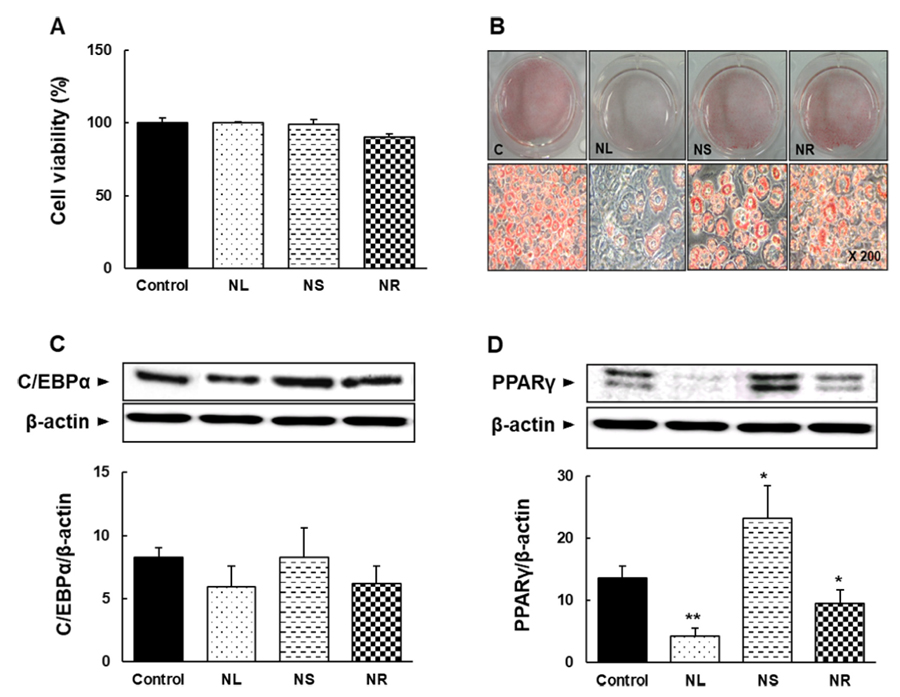
Effect of NN extracts on cell viability (A), Oil-red-O staining (B), C/EBPα (C) or PPARγ (D) expression in 3T3-L1 adipocytes. Control (non-treated); NL, addition of N. nucifera leaf extract at 250 μg/mL; NS, addition of N. nucifera seed extract at 250 μg/mL; NR, addition of N. nucifera root extract at 250 μg/mL. *p < 0.05 and **p < 0.01 vs control.
Numerous consequences for genes involved in adipogenesis and lipid metabolism in adipocytes have been well elucidated.8 UCP2, which is related to fat oxidation, induces effective energy consumption by releasing it as heat instead of accumulating it as fat for continuous excess energy intake in white adipose tissue (WAT).8,9 Some studies have shown that lipid metabolism and weight loss in obese animal models and 3T3-L1 adipocytes are due to elevate energy expenditure by stimulation of UCP2 or UCP3 expression.10,21 Bugge et al., demonstrated that UCP2 and UCP3 expression was activated by the peroxisome proliferator-activated receptors (PPARs).29 In addition, NL extract can up-regulate lipid metabolism through expression of UCP3 mRNA in C2C12 myotubes, but no study results in adipocytes have been reported.18 We investigated whether the expression of UCP2 in 3T3- L1 adipocytes was activated by NL extract. As shown in Fig. 2, we found that NL extract significantly enhances UCP2 expression as a marker of fat consumption. Therefore, our results suggest that action of NL extract on lipid metabolism is associated with the upregulation of fatty oxidation enzyme such as UCP2.
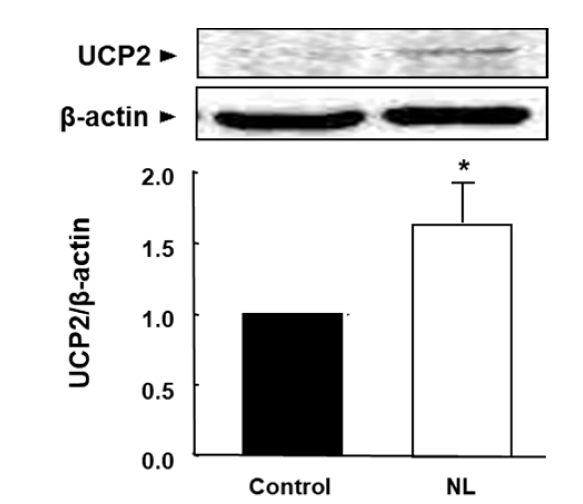
Effect of N. nucifera leaf extract on UCP2 expression in 3T3-L1 adipocytes. Control (non-treated); NL, addition of N. nucifera leaf extract at 250 μg/mL. *p < 0.05 vs control.
Finally, we examined the anti-obesity effect of NL extract in animal models to confirm the results of cell experiments. NL extract was orally administered to obese db/db mice for 6 weeks. The change in body weight was different between obese control group and treated group of NL extract from 2 weeks, and showed the same trend until the end of the experiment (Fig. 3). Treatment with NL extract at a dose of 100 mg/kg BW significantly decreased body weight. Food efficacy ratio (FER) was reduced by administration of NL extract compared to control db/db mice, whereas food intake was no difference between groups (Table 1). The total cholesterol levels of liver, feces, and serum all significantly suppressed in NL extract treated group, and triglyceride level was only reduced in liver tissue (Fig. 4). The oral administration of NL extract significantly decreased the size of adipocytes, which was further reduced in 100 mg/kg rather than 400 mg/kg BW group (Fig. 5). Interestingly, we found that the expression of PPARγ, a key transcription factor that regulated adipognesis and lipid metabolism, was dramatically decreased by treatment of NL extract compared with the obese db/db mice (Fig. 6). In the previous results, the beneficial effects of NL or main components (quercetin-3-O-β-glucuronide, quercetin, nuciferine) on obesity and obesity-related diseases involving inflammation and hepatic disease have well provided in vivo and in vitro.11,20,30-32 Therefore, our results showed that NL extract is a potential agent for the regulation of adipogenesis and lipid metabolism via PPARγ activation in obese db/db mice.
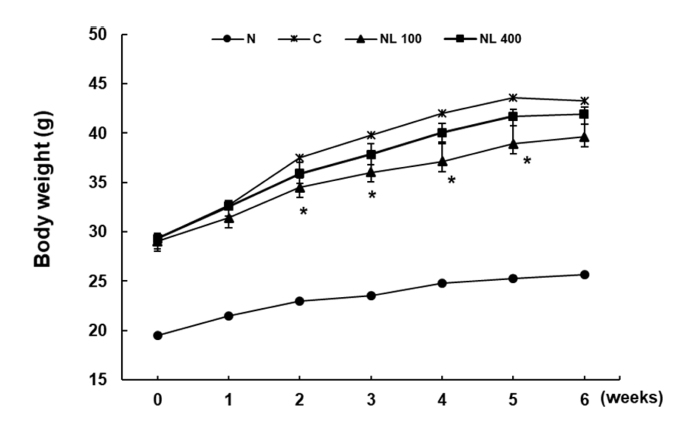
Effect of N. nucifera leaf extract on body weight in db/db mice. N, normal (C57BL/6 Cr SIc); C, control (non-treatment db/db mice); NL 100, treatment of N. nucifera leaf extract at 100 mg/kg BW in db/db mice; NL 400, treatment of N. nucifera leaf extract at 400 mg/kg BW in db/db mouse. *p < 0.05 vs control.
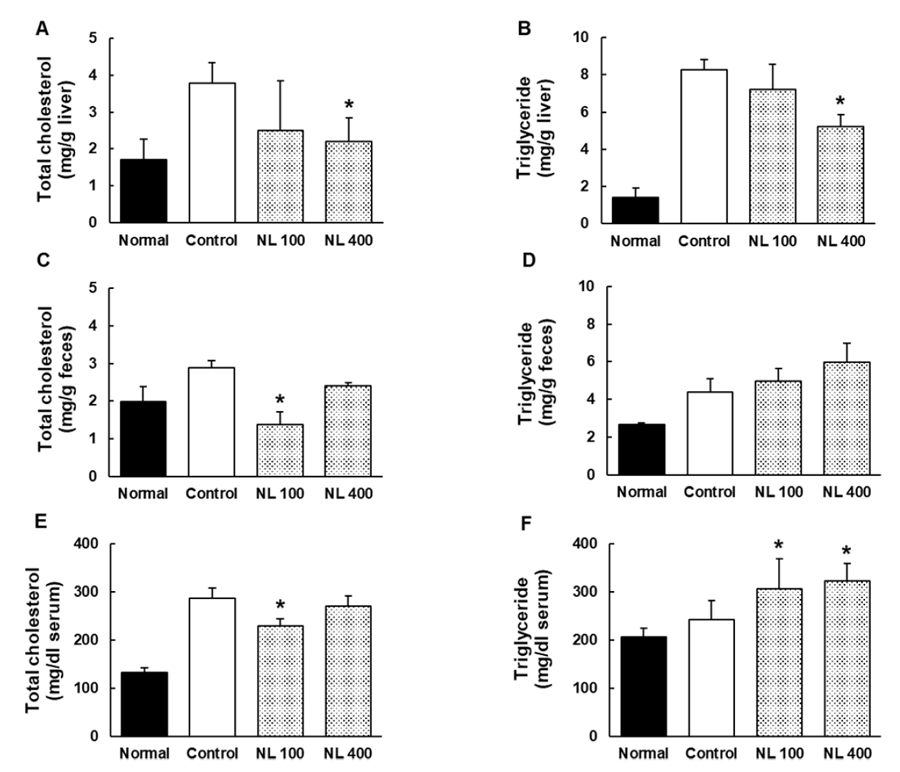
Effect of N. nucifera leaf extract on total cholesterol (A, C, E) and triglyceride (B, D, F) in liver (A and B), feces (C and D) and serum (E and F) of db/db mice. N, normal (C57BL/6 Cr SIc); C, control (non-treatment db/db mice); NL 100, treatment of N. nucifera leaf extract at 100 mg/kg BW in db/db mice; NL 400, treatment of N. nucifera leaf extract at 400 mg/kg BW in db/db mouse. *p < 0.05 vs control.

Effect of N. nucifera leaf extract on morphological change in adipose tissue of db/db mice. N, normal (C57BL/6 Cr SIc); C, control (non-treatment db/db mice); NL 100, treatment of N. nucifera leaf extract at 100 mg/kg BW in db/db mice; NL 400, treatment of N. nucifera leaf extract at 400 mg/kg BW in db/db mouse. *p < 0.05 and **p < 0.01 vs control.
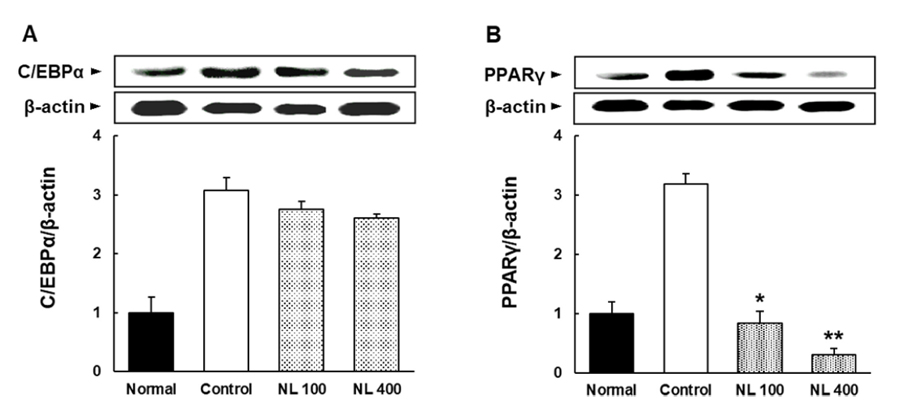
Effect of N. nucifera leaf extract on the protein expression of C/EBPα (A) and PPARγ (B) in adipose tissue of db/db mice. N, normal (C57BL/6 Cr SIc); C, control (non-treatment db/db mice); NL 100, treatment of N. nucifera leaf extract at 100 mg/kg BW in db/db mice; NL 400, treatment of N. nucifera leaf extract at 400 mg/kg BW in db/db mouse. *p < 0.05 and **p < 0.01 vs control.
In conclusion, we found that the NL extract among various parts (leaf, seed, and root) of NN can be control lipid metabolism and adipocyte differentiation through downregulation of PPARγ and upregulation of UCP2 in 3T3-L1 adipocytes and obese db/db mice. Moreover, it is also thought that the difference of NN extraction method may be differently explained in the protective mechanisms of obesity and obesity-related diseases. However, it is necessary to isolate and identify bioactive substances with the bioassay-guided fractionation in further experimental procedure.
Acknowledgments
This research was supported by research funds from the Convergence Research Laboratory established by the Mokpo National University (MNU) Innovation Support Project in 2020.
References
-
Bray, G. A. J. Med. Chem. 2006, 49, 4001-4007.
[https://doi.org/10.1021/jm0680124]

-
James, W. P. T. Int. J. Obes (Lond). 2008, 7, S120-S126.
[https://doi.org/10.1038/ijo.2008.247]

- Nishimura, S.; Manabe, I.; Nagai, R. Discov. Med. 2009, 8, 55-60.
-
Ali, A. T.; Hochfeld, W. E.; Myburgh, R.; Pepper, M. S. Eur. J. Cell Biol. 2013, 92, 229-236.
[https://doi.org/10.1016/j.ejcb.2013.06.001]

-
Ntambi, J. M.; Kim, Y. C. J. Nutr. 2000, 130, 3122S-3126S.
[https://doi.org/10.1093/jn/130.12.3122S]

-
Jeẑek, P.; Garlid, K. D. Int. J. Biochem. Cell Biol. 1998, 30, 1163-1168.
[https://doi.org/10.1016/S1357-2725(98)00076-4]

-
Vidal-Puig, A.; Solanes, G.; Grujic, D.; Flier, J. S.; Lowell, B. B. Biochem. Biophys. Res. Commun. 1997, 235, 79-82.
[https://doi.org/10.1006/bbrc.1997.6740]

-
Jia, J. J.; Zhang, X.; Ge, C. R.; Jois, M. Obes. Rev. 2009, 10, 519-526.
[https://doi.org/10.1111/j.1467-789X.2009.00569.x]

-
Pedersen, S. B.; Børglum, J. D.; Kristensen, K.; Nørrelund, H.; Otto, J.; Jørgensen, L.; Richelsen, B. Int. J. Obes. Relat. Metab. Disord. 2000, 24, 968-975.
[https://doi.org/10.1038/sj.ijo.0801265]

-
Lu, H. Y.; Zeng, H.; Zhang, L.; Porres, J. M.; Cheng, W. H. J. Nutr. Biochem. 2018, 60, 9-15.
[https://doi.org/10.1016/j.jnutbio.2018.06.004]

-
Paudel, K. R.; Panth, N. Evid. Based Complement. Alternat. Med. 2015, 2015, 789124.
[https://doi.org/10.1155/2015/789124]

-
Sharma, B. R.; Kim, M. S.; Rhyu, D. Y. J. Tradit. Chin. Med. 2016, 36, 71-77.
[https://doi.org/10.1016/S0254-6272(16)30011-5]

-
Sharma, B. R.; Oh, J.; Kim, H. A.; Kim, Y. J.; Jeong, K. S.; Rhyu, D. Y. Am. J. Chin. Med. 2015, 43, 681-694.
[https://doi.org/10.1142/S0192415X15500421]

- Mukherjee, P. K.; Mukherjee, D.; Maji, A. K.; Rai, S.; Heinrich, M. J. Pharm. Pharmacol. 2009, 61, 407-422.
-
Sharma, B. R.; Kim, H. J.; Kim, M. S.; Park, C. M.; Rhyu, D. Y. Nutr. Res. 2017, 47, 44-52.
[https://doi.org/10.1016/j.nutres.2017.09.002]

-
Sharma, B. R.; Park, C. M.; Kim, H. A.; Kim, H. J.; Rhyu, D. Y. Phytother. Res. 2019, 33, 2765-2774.
[https://doi.org/10.1002/ptr.6462]

-
Yanina, I. Y.; Tuchin, V. V.; Navolokin, N. A.; Matveeva, O. V.; Bucharskaya, A. B.; Maslyakova, G. N.; Altshuler, G. B. J. Biomed. Opt. 2012, 17, 058002.
[https://doi.org/10.1117/1.JBO.17.5.058002]

-
Ono, Y.; Hattori, E.; Fukaya, Y.; Imai, S.; Ohizumi, Y. J. Ethnopharmacol. 2006, 106, 238-244.
[https://doi.org/10.1016/j.jep.2005.12.036]

-
Ohkoshi, E.; Miyazaki, H.; Shindo, K.; Watanabe, H.; Yoshida, A.; Yajima, H. Planta. Med. 2007, 73, 1255-1259.
[https://doi.org/10.1055/s-2007-990223]

-
Lin, M. C.; Kao, S. H.; Chung, P. J.; Chan, K. C.; Yang, M. Y.; Wang, C. J. J. Agric. Food Chem. 2009, 57, 5925-5932.
[https://doi.org/10.1021/jf901058a]

-
Wu, C. H.; Yang, M. Y.; Chan, K. C.; Chung, P. J.; Ou, T. T.; Wang, C. J. J. Agric. Food Chem. 2010, 58, 7075-7081.
[https://doi.org/10.1021/jf101415v]

-
Velusami, C. C.; Agarwal, A.; Mookambeswaran, V. Evid. Based Complement. Alternat. Med. 2013, 2013, 145925.
[https://doi.org/10.1155/2013/145925]

-
Ahn, J. H.; Kim, E. S.; Lee, C.; Kim, S.; Cho, S. H.; Hwang. B. Y.; Lee. M. K. Bioorg. Med. Chem. Lett. 2013, 23, 3604-3608.
[https://doi.org/10.1016/j.bmcl.2013.04.013]

-
Wang, Z.; Hu, J.; Hamzah, S. S.; Ge, S.; Lin, Y.; Zheng, B.; Zeng, S.; Lin, S. J. Agric. Food Chem. 2019, 67, 1092-1103.
[https://doi.org/10.1021/acs.jafc.8b05281]

-
Lin, S.; Wang, Z.; Lin, Y.; Ge, S.; Hamzah, S. S.; Hu, J. J. Funct. Foods 2019, 58, 74-84.
[https://doi.org/10.1016/j.jff.2019.04.054]

-
Boo, H. O.; Kim, H. H.; Barasch, D.; Nemirovski, A.; Lee, M. S.; Gorinstein, S.; Ku, Y. G. Eur. Food Res. Technol. 2017, 243, 689-700.
[https://doi.org/10.1007/s00217-016-2782-1]

- Ye, L.; Wang, X.; Konno, T.; Gong, X.; Ding, H.; Yan, H.; Ji, Z. S.; Liu, E. Nat. Prod. Res. 2022, 36, 4776-4781.
-
Nguyen, H. H. T.; Lam, A. T.; Pham, T. N. V.; Le, T. X.; Le, P. K. IOP Conf. Series: Earth and Environmental Science. 2021, 947, 012009.
[https://doi.org/10.1088/1755-1315/947/1/012009]

-
Bugge, A.; Siersbaek, M.; Madsen, M. S.; Göndör, A.; Rougier, C.; Mandrup, S. J. Biol. Chem. 2010, 285, 17310-17317.
[https://doi.org/10.1074/jbc.M110.120584]

-
Li, F.; Sun, X. Y.; Li, X. W.; Yang, T.; Qi, L. W. J. Chromatogr. B Analyt. Technol. Biomed. Life Sci. 2017, 1040, 186-191.
[https://doi.org/10.1016/j.jchromb.2016.12.017]

-
Liu, E.; Tsuboi, H.; Ikegami, S.; Kamiyama, T.; Asami, Y.; Ye, L.; Oda, M.; Ji, Z. S. Plant Foods Hum. Nutr. 2021, 76, 377-384.
[https://doi.org/10.1007/s11130-020-00852-w]

-
Wan, Y.; Xia, J.; Xu, J. F.; Chen, L.; Yang, Y.; Wu, J. J.; Tang, F.; Ao, H.; Peng, C. Pharmacol. Res. 2022, 175, 106002.
[https://doi.org/10.1016/j.phrs.2021.106002]

